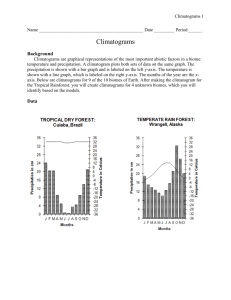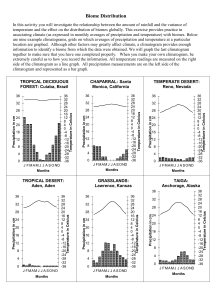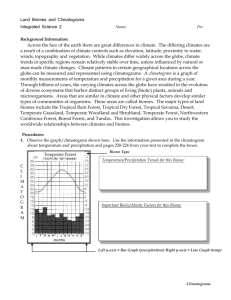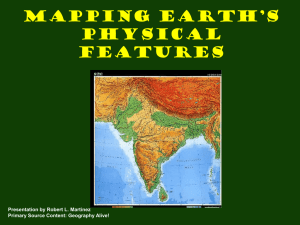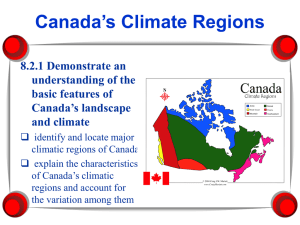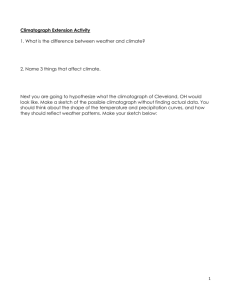HW: Create your own climatogram - Liberty Union High School District
advertisement
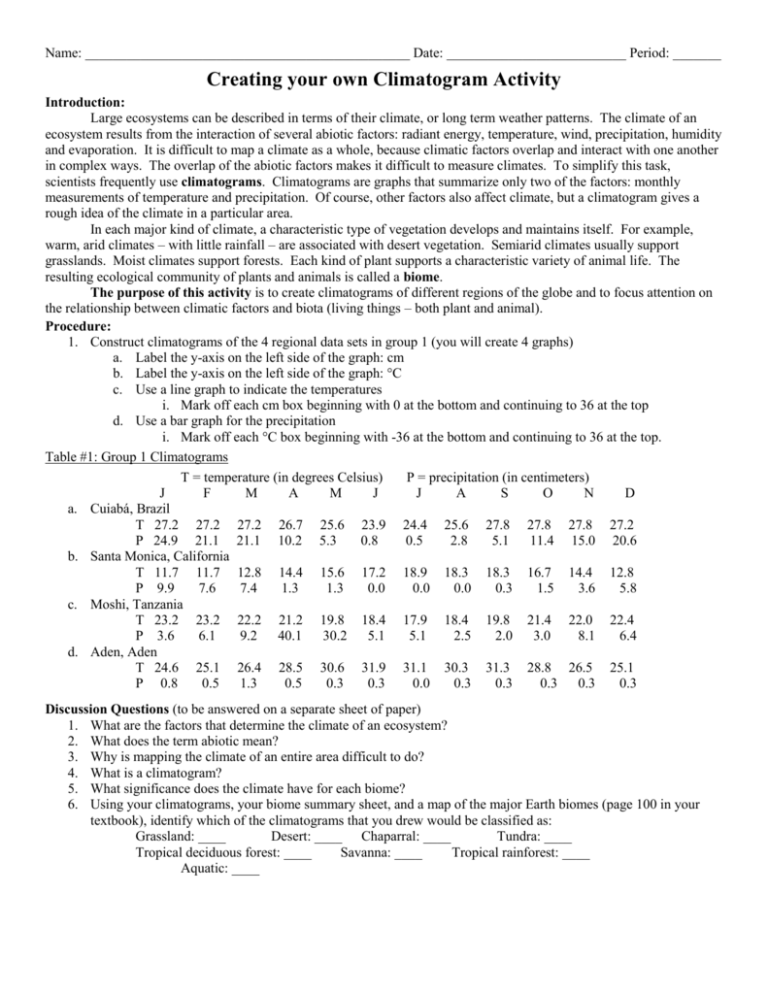
Name: _______________________________________________ Date: __________________________ Period: _______ Creating your own Climatogram Activity Introduction: Large ecosystems can be described in terms of their climate, or long term weather patterns. The climate of an ecosystem results from the interaction of several abiotic factors: radiant energy, temperature, wind, precipitation, humidity and evaporation. It is difficult to map a climate as a whole, because climatic factors overlap and interact with one another in complex ways. The overlap of the abiotic factors makes it difficult to measure climates. To simplify this task, scientists frequently use climatograms. Climatograms are graphs that summarize only two of the factors: monthly measurements of temperature and precipitation. Of course, other factors also affect climate, but a climatogram gives a rough idea of the climate in a particular area. In each major kind of climate, a characteristic type of vegetation develops and maintains itself. For example, warm, arid climates – with little rainfall – are associated with desert vegetation. Semiarid climates usually support grasslands. Moist climates support forests. Each kind of plant supports a characteristic variety of animal life. The resulting ecological community of plants and animals is called a biome. The purpose of this activity is to create climatograms of different regions of the globe and to focus attention on the relationship between climatic factors and biota (living things – both plant and animal). Procedure: 1. Construct climatograms of the 4 regional data sets in group 1 (you will create 4 graphs) a. Label the y-axis on the left side of the graph: cm b. Label the y-axis on the left side of the graph: °C c. Use a line graph to indicate the temperatures i. Mark off each cm box beginning with 0 at the bottom and continuing to 36 at the top d. Use a bar graph for the precipitation i. Mark off each °C box beginning with -36 at the bottom and continuing to 36 at the top. Table #1: Group 1 Climatograms T = temperature (in degrees Celsius) P = precipitation (in centimeters) J F M A M J J A S O N D a. Cuiabá, Brazil T 27.2 27.2 27.2 26.7 25.6 23.9 24.4 25.6 27.8 27.8 27.8 27.2 P 24.9 21.1 21.1 10.2 5.3 0.8 0.5 2.8 5.1 11.4 15.0 20.6 b. Santa Monica, California T 11.7 11.7 12.8 14.4 15.6 17.2 18.9 18.3 18.3 16.7 14.4 12.8 P 9.9 7.6 7.4 1.3 1.3 0.0 0.0 0.0 0.3 1.5 3.6 5.8 c. Moshi, Tanzania T 23.2 23.2 22.2 21.2 19.8 18.4 17.9 18.4 19.8 21.4 22.0 22.4 P 3.6 6.1 9.2 40.1 30.2 5.1 5.1 2.5 2.0 3.0 8.1 6.4 d. Aden, Aden T 24.6 25.1 26.4 28.5 30.6 31.9 31.1 30.3 31.3 28.8 26.5 25.1 P 0.8 0.5 1.3 0.5 0.3 0.3 0.0 0.3 0.3 0.3 0.3 0.3 Discussion Questions (to be answered on a separate sheet of paper) 1. What are the factors that determine the climate of an ecosystem? 2. What does the term abiotic mean? 3. Why is mapping the climate of an entire area difficult to do? 4. What is a climatogram? 5. What significance does the climate have for each biome? 6. Using your climatograms, your biome summary sheet, and a map of the major Earth biomes (page 100 in your textbook), identify which of the climatograms that you drew would be classified as: Grassland: ____ Desert: ____ Chaparral: ____ Tundra: ____ Tropical deciduous forest: ____ Savanna: ____ Tropical rainforest: ____ Aquatic: ____

